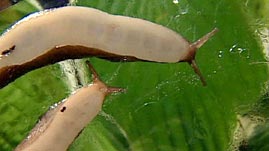Teachers' Domain - Digital Media for the Classroom and Professional Development
User: Preview

Source: Massachusetts Institute of Technology
In the field of robotic locomotion, designers are finding the study of animal and insect movement an exciting area of research. Inspired by nature, these designers are creating robots that are extremely nimble and capable of moving over a variety of surfaces, such as rough terrain, steep inclines, and even vertical walls. In this video segment adapted from the Massachusetts Institute of Technology, learn how a team from the Mechanical Engineering Department is using snail movement as inspiration for robotic locomotion.
Most robots rely on wheels for movement. However, although wheels are efficient for traveling over flat horizontal surfaces, it is difficult for wheeled robots to maneuver over bumpy surfaces, climb steep inclines, or negotiate obstacles. Over the years, engineers and designers have made great improvements in wheeled robotic locomotion, and advanced designs have allowed wheeled robots to successfully negotiate challenging terrain. For example, the Mars rovers have been able to maneuver the uneven and unknown landscape of that planet with amazing success.
To further increase robot mobility, researchers are looking to nature for ideas. The diversity of life on Earth exhibits many interesting modes of locomotion that might be applied to robotic movement. By studying the motion of animals such as snails, snakes, crabs, geckos, squirrels, inchworms, and cockroaches, engineers are creating robots with remarkable movement capabilities.
For example, Ariel, a robot that is designed to locate mines on the ocean floor, is modeled after a crab. With its streamlined body and legs that walk sideways, it can reliably climb obstacles, resist waves, and walk both on land and under water. Ariel's designers were inspired by crabs, but they also improved upon nature's design — if turbulent waves should flip Ariel over, rather than struggle on its back like a real crab, Ariel's legs are able to rotate so that the body becomes inverted and the robot can continue moving.
One of the biggest challenges for designers has been to create a robot capable of climbing vertical surfaces. Engineers are currently developing robots that are not only able to scale vertical walls but can also traverse ceilings. Some robots, such as Mecho-Gecko and RiSE, are able to climb vertical surfaces because of their specially designed legs and feet. Robosnail, the robot featured in the video, climbs walls and ceilings using an entirely different mechanism: just as a real snail travels on a trail of slime, Robosnail moves by propelling itself over a layer of fluid. Using artificial slime, Robosnail moves by undulating a single flexible foot that creates compression waves in the slime, which in turn push the robot over the surface.
Inspiration for robotic motion can even be found in single-celled organisms. Some researchers are working on "whole-skin locomotion," in which the entire outer surface of the robot is used for traction. Inspired by the movement of amoebas, this tube-shaped robot travels by turning itself inside out — as it moves, the outer surface continually flows into the center hollow area, propelling the robot forward. A robot such as this could be used in tight spaces, for example for search and rescue in disaster areas, or on a smaller scale for medical procedures such as exploring the digestive tract.
 Loading Standards
Loading Standards Teachers' Domain is proud to be a Pathways portal to the National Science Digital Library.
Teachers' Domain is proud to be a Pathways portal to the National Science Digital Library.
